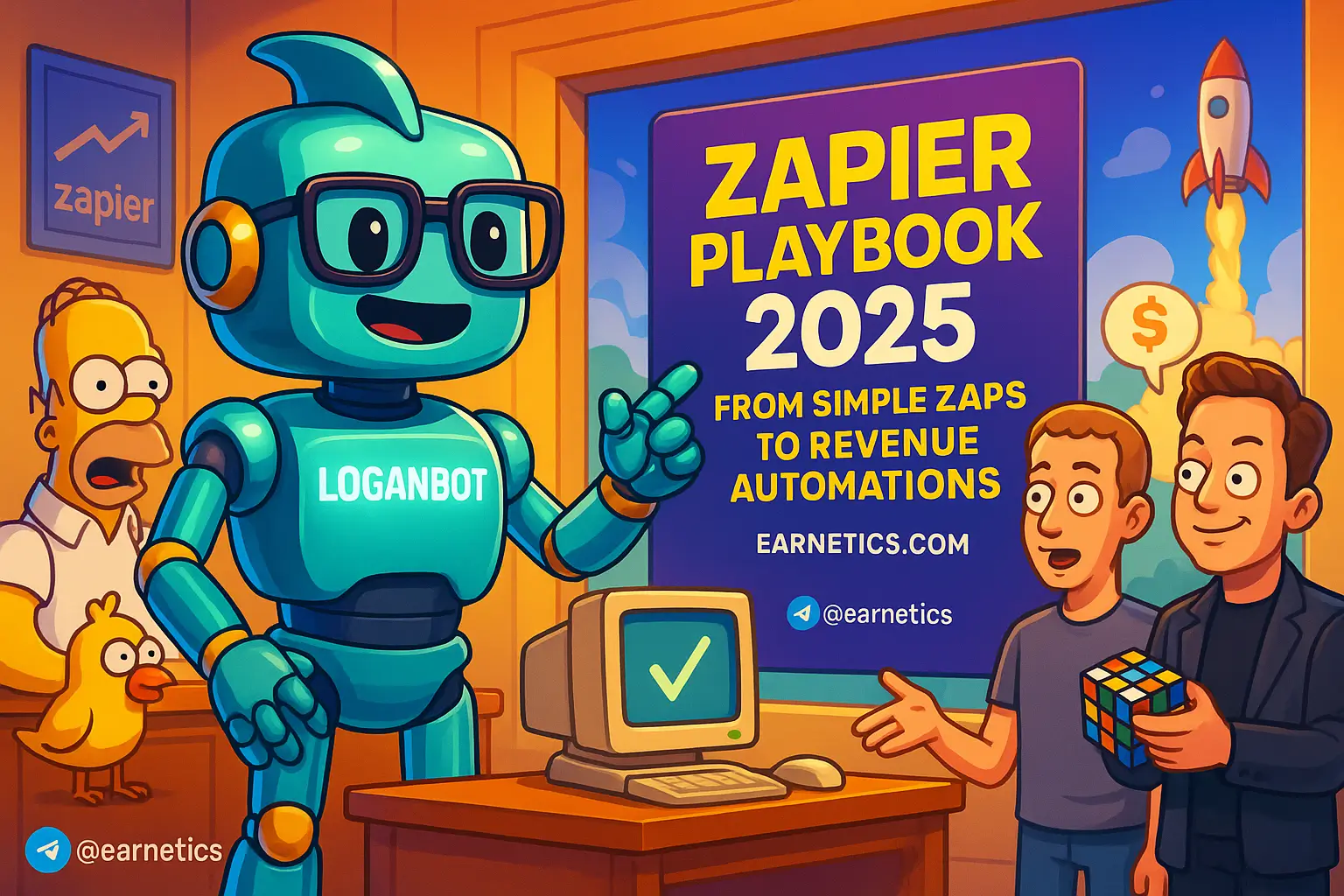AI, APIs, and money: How the Zapier Playbook 2025 turned my Zaps into revenue machines
Want faster revenue? Zapier Playbook 2025 teaches how I transformed simple Zaps into full revenue automations that cut tedious work, speed lead-to-revenue, prevent errors, and scale.
I wrote this because I kept watching the same painful problems repeat across startups I advised – manual handoffs, missed leads, and spreadsheets that were basically a betting pool for human error. The Zapier Playbook 2025 is my answer: a practical, tactical roadmap that moves you from single-step Zaps to revenue automations that actually impact the top line. In this guide I unpack the strategy, templates, KPIs, and governance you need to scale automation safely.
Who is this for? Founders who want predictable growth, ops folks tired of firefighting, revenue teams chasing faster close times, and automation leads building a repeatable practice. Over the next few sections I’ll walk through strategy and planning, advanced Zap design, revenue-specific workflows, and the governance and cost controls that keep everything humming.
Quick keyword snapshot for nerds and SEO bots: primary keyword – Zapier Playbook 2025; secondary keywords – Zapier automation strategies, advanced Zapier workflows, Zapier for sales automation, Zapier best practices 2025, Zap automation templates, revenue automations; LSI terms – workflow automation, no-code automation, webhook integrations, API integration, Zap templates, task usage optimization, revops automation, lead enrichment, error handling, monitoring. Read on and you’ll get concrete templates – like new lead → enrichment → CRM create → Slack alert – plus the playbook I actually used when things went sideways. Expect real examples, a prioritization matrix, and the exact 30/60/90 checklist I ran in my pilot.
Start Smart: Automation Strategy & Planning
Map processes first
I always start with a process map. If you skip this, you’ll automate chaos and make it faster. I traced every customer-facing and revenue touchpoint with sticky notes, and then flagged the frequent time drains, error spots, and revenue-impact steps.
To find the highest-impact workflows, ask three questions: How often does this happen? How long does it take human time? What happens if it fails? Tasks that score high on frequency and cost of failure are automation gold. I used a simple prioritization matrix – effort vs impact – to surface quick wins first. In my playbook, a quick-win looked like auto-enriching ad leads and routing them to reps, which saved hours and stopped the “lost lead” drama.
Takeaway: map, score, prioritize. If you can’t measure before building, you can’t prove value after.
App inventory & integration choices
Next, inventory everything. I built a one-page spreadsheet with app name, purpose, native Zapier integration (yes/no), available triggers, actions, rate limits, and auth method. This matters because not all integrations are created equal – some apps have robust triggers and others require HTTP requests or OAuth gymnastics.
When native integrations were thin, I checked the API docs and planned for Webhooks or Code by Zapier. I also noted rate throttles and Zapier plan tiers because a spike in leads can blow your task allotment and your mind if you’re not ready. If you see limit warnings, consider batching, scheduling Zaps, or moving heavy transforms to middleware.
Practical tip: include a column for “retry behavior” and “idempotency support” in your inventory. Those two details saved me from a weekend of duplicate invoices.
Automation blueprint & templates
I design a blueprint for every automation before touching Zapier. Blueprints include trigger, enrichment calls, transformation logic, destination objects, SLA notifications, and error fallback. My naming convention looks like this: team – function – trigger – version. It sounds anal, but versioning paid off when dozens of Zaps started multiplying.
Example blueprint I used in week one: new lead (ad webhook) → enrichment API call (company, email validation) → CRM create or update → assignment logic → Slack alert to rep → add to nurture sequence if unassigned. I saved that as a template and reused it across different lead sources.
Lesson: templates speed deployment and make audits painless. If you document the blueprint, you’ll thank yourself when ownership changes.
Build Robust Workflows: Advanced Zap Design
Multi-step Zaps & branching logic
Simple Zaps are great for one-offs, but real-world flows need branching. Paths and Filters are your friends. I stopped creating duplicate Zaps by using conditional Paths to route leads by region, product interest, or score. That way one Zap handled multiple outcomes cleanly.
Use Filters early in the flow to reject irrelevant data, then branch with Paths to different teams or follow-ups. For example, if a lead’s score is above threshold A, Path A creates an opportunity and notifies sales. If below threshold, Path B starts nurture. This approach kept my task usage lower and logic centralized.
Mini-hook: if you love tidy logic, you’ll love building with Paths. If you hate debugging, plan for it with clear test cases.
Error handling, retries & idempotency
APIs fail. Period. My playbook treats error handling as a first-class feature. I built retries with exponential backoff, fallback steps, and alerting that pinged Slack when something required human attention. I also used dedupe keys and Storage by Zapier as lightweight idempotency layers so duplicate webhooks didn’t create duplicate records.
If an API returns a 429 or 500, I let Zapier retry but also log the event to a monitoring sheet and notify an owner after X failed attempts. This saved countless support tickets because instead of silent failures, we had visibility and SLA ownership.
Quick takeaway: plan for failure, build for retries, and use uniqueness keys to avoid duplication.
Extend with Code & APIs
Sometimes Zapier’s built-in actions aren’t enough. I’d drop into Code by Zapier for small transforms and use Webhooks for custom API calls. For heavyweight logic, I offloaded to external middleware like AWS Lambda or Make, which let me keep Zaps readable and affordable.
Mini-case: I needed a custom enrichment that merged multiple API results and normalized fields. I triggered a webhook, hit a small Lambda function that called three APIs, parsed responses, returned a clean payload, and Zapier continued. It felt fancy, but it was actually cheaper than building a full integration.
Rule of thumb: use Code or middleware when transforms get messy or you need to centralize complex business logic.
Automate Revenue Workflows: Sales & RevOps Use Cases
Lead capture to CRM sync
Revenue automation starts at lead capture. My core Zap pattern for sales involved dedupe, enrichment, assignment, and SLA notifications. I used email hashes and CRM dedupe fields to prevent duplicates, called enrichment APIs for firmographics, assigned leads by territory rules, and fired SLA reminders if unclaimed after X minutes.
Templates I relied on included forms-to-CRM, Facebook/Google lead ads to CRM, and chat transcripts to CRM. For ad leads I always added an extra validation step – email verification – which dropped our bounce rate and improved rep confidence. That tiny step increased conversion because reps stopped wasting time on junk.
Pro tip: document assignment rules and include a manual claim button in Slack so reps can instantly take ownership if the automated rules miss a nuance.
Deal progression & revenue triggers
I automated stage progression and document generation. When an opportunity hit “proposal ready” I created a draft proposal, attached pricing, and notified finance. When a signed contract came in, a Zap created an invoice, updated subscription records, and triggered welcome sequences. That tight handoff reduced billing delays and human error.
Example Zap: Opportunity stage → generate proposal via template (Google Docs or PandaDoc) → notify rep and finance → on signed webhook, create invoice and update CRM. This flow cut our time-to-bill by days and made forecasting more reliable.
Takeaway: automate not just capture, but the handoffs that cost time and revenue.
Revenue reporting & commission workflows
Automations are great at moving data into dashboards. I pushed closed deals to Google Sheets and a BI tool, triggered recalculations for commissions, and updated attribution fields. That meant finance and sales ops stopped begging for exports and could trust the numbers.
I also automated commission calculations and batched exports to payroll systems. For attribution, I synced UTM and campaign data into the CRM so reporting reflected the real marketing source. That made our CAC and LTV reporting much less fuzzy, which helped prioritize channels.
Tip: create a monthly automation health check that validates totals between CRM and BI snapshots to catch drift early.
Scale, Secure, and Measure Automations
Governance & teamwork
When automations expand, chaos is the real risk. I implemented an ownership model where each Zap had an owner, purpose, and runbook. Naming standards and version tags helped when multiple contributors edited workflows. I also set role-based access so only trusted accounts could change production Zaps.
Onboarding contributors meant a short checklist – read the blueprints, clone a template, run tests in a sandbox, and pass a review. This made scaling predictable and kept surprises to a minimum.
Lesson: governance is not bureaucracy – it’s how you survive growth without burning the team out.
Monitoring, observability & SLAs
Visibility is everything. I created a lightweight observability stack: Zapier task logs, a heartbeat Zap that sends a daily status, a failure dashboard in Google Sheets or Looker, and Slack alerts for critical errors. KPIs I tracked included automation uptime, manual hours saved, lead conversion lift, and time-to-close improvements.
Set SLAs for response to failures – for instance, 60 minutes to acknowledge and 24 hours to remediate high-impact failures. That clarity reduced panic and focused attention where it mattered.
Actionable KPI: measure manual hours saved by sampling before-and-after times for each automated task, then multiply by hourly cost to justify plan upgrades.
Cost optimization & limits management
Zapier task usage can become expensive if you’re not careful. I scheduled non-urgent Zaps to run off-peak, batched operations where possible, and used filters to avoid wasted tasks. For heavy transforms I moved logic to middleware or scheduled scripts that processed batches once per hour instead of firing per event.
Choose your plan based on peak task forecasts, not average usage. Have fallback strategies for spikes – like queuing to an SQS or a Google Sheet where a batch Zap processes rows when limits are reached.
Final tip: monitor task usage daily for the first month after any new automation – that’s when surprises bite.
Conclusion
Wrapping up, the Zapier Playbook 2025 is about shifting from tactical, one-off Zaps to a thoughtful automation practice that moves revenue needles. I walked you through mapping and prioritizing workflows, auditing apps and integrations, creating reusable blueprints, and building advanced Zap logic with error handling and middleware where needed. Then we covered revenue-centric flows – lead capture, proposal handoffs, invoicing, and reporting – and the governance, monitoring, and cost controls you need to scale without chaos.
Here’s what I recommend doing in the next 90 days: 30 days – audit your processes and app inventory; 60 days – pilot two revenue Zaps (one lead capture, one deal progression) and instrument KPIs; 90 days – review results, document blueprints, and scale the highest-performing automations. My starter templates are the lead enrichment-to-CRM flow, stage-to-proposal generator, and monthly commission export – deploy those and you’ll feel the ROI quick.
To future-proof your automations, monitor API changes, modularize logic so Zaps are single-purpose, and create an automation culture where small iterative improvements are rewarded. Schedule quarterly reviews, maintain a center of excellence, and always tie automations back to KPIs – uptime, manual hours saved, conversion lift, and time-to-close. That’s how you keep speed without breaking things.
⚡ Here’s the part I almost didn’t share… When I hit a wall with complex transformations, automation saved me. My hidden weapon is Make.com – it handled batching and heavy transforms and let Zapier stay the orchestration layer. You can get an exclusive 1-month Pro (10,000 ops) free to try it.
🔥 Don’t walk away empty-handed. If this guide clicked, my free eBook Launch Legends: 10 Epic Side Hustles to Kickstart Your Cash Flow with Zero Bucks goes deeper on systems and templates that pair perfectly with revenue automations.
Want more templates and playbooks like this? Explore more guides on Earnetics.com and check Zapier’s official automation resources at zapier.com/blog/automation to stay current.


